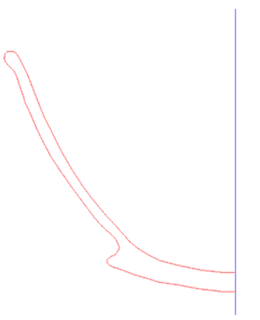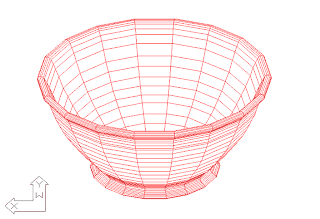The final case study moves away from the view of VRML as functioning solely alongside applications of archaeological-GIS, to concentrate upon the enormous archaeological potential to be gained from VRML in its own right, as a means of displaying, communicating and engaging with archaeological data.
The majority of problems that arise in realising archaeological data via VRML derive from the near infinite variability of landscape-derived data, and the complications that occur in trying to capture its shape and form effectively. With individual artefacts and structures these problems largely disappear, due to the relative simplicity and regularity of the form of many of these features. To illustrate the enormous utility of VRML in these contexts, and stress the routine nature of its implementation, we have taken the example of a simple pot drawing, and looked at how VRML may be used to enhance this means of representation to produce a more sensuous and interactive typological record.

The traditional convention for representing the shape and form of a ceramic vessel relies upon the production of a scaled profile drawing, taken as a hypothetical slice vertically down through the body of the vessel (Figure 23). Within a CAD utility it is a routine task to digitise the drawn profile, and sweep it around to produce a simple 3-dimensional representation of the source artefact (Figure 24).

In this example the section drawing was rotated through 360 degrees to produce a faceted model. More complex models, for example those incorporating details such as handles, would require construction using a number of such swept shapes. The resultant CAD file was converted to a VRML format using a shareware file conversion utility called Wcvt2Pov. The whole process, from digitising the profile drawing through to the generation of the VRML model (Figure 25 - in VRML) took less than fifteen minutes and could, in part, be automated to enable a library of models to be produced quickly and efficiently.
To keep the model small, the number of profiles produced during the original 360 degree CAD sweep was restricted to sixteen. This has resulted in the faceting of the model being apparent in the final rendering. By increasing the number of source profiles a better approximated curve can easily be achieved but at the expense of increasing VRML file size. Future generations of VRML browsers promise to overcome this compromise by producing smoother renderings from models with fewer facets, through the use of better internal smoothing algorithms.

With the VRML model in place it now becomes possible to think beyond the need for a series of static, abstracted line drawings in disseminating a given typological sequence. Researchers would be free not only to compare and contrast the recorded profiles but, through a simple action of the mouse, view, move, examine and compare the recorded types as full and sensuous objects.
© Internet Archaeology
URL: http://intarch.ac.uk/journal/issue1/gillings/part10c.html
Last updated: Tue Sep 5 1996